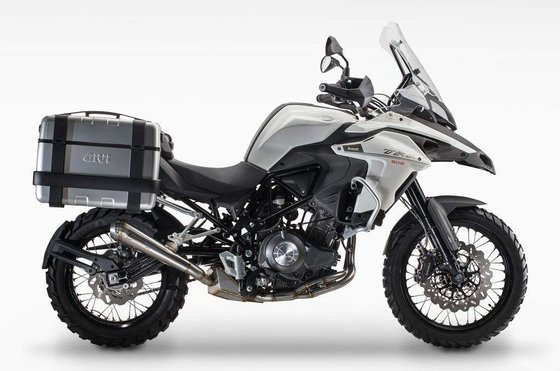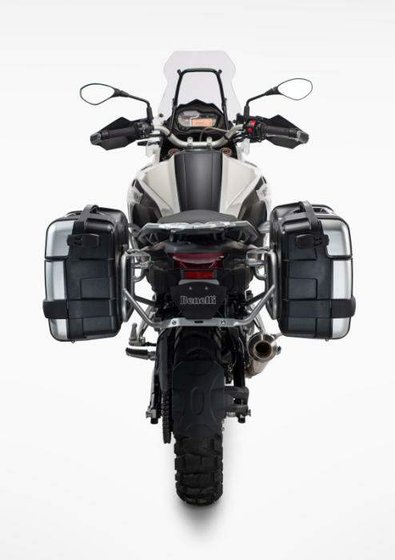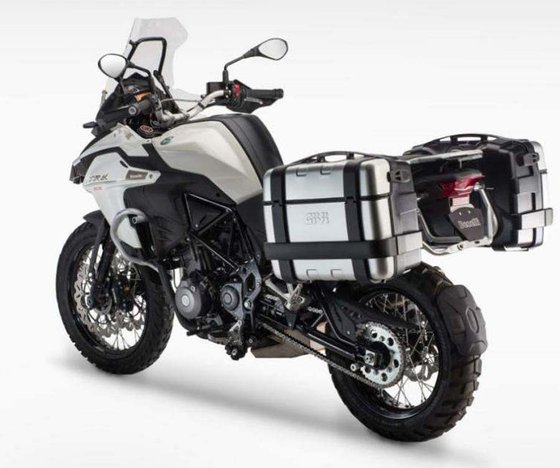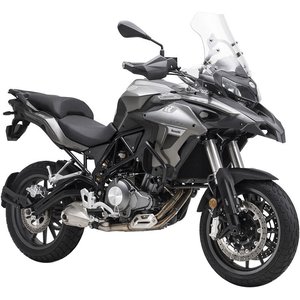Benelli TRK 502 (2016-2021): A Gateway to Adventure Touring

Introduction
The Benelli TRK 502 arrived in 2016 as a bold statement in the mid-size adventure touring segment. Designed to blend long-distance comfort with off-road capability, this Italian-Chinese collaboration quickly gained attention for its aggressive styling, accessible performance, and surprising value. Over its five-year production run, the TRK 502 carved out a niche as a "starter adventure bike" for riders seeking touring versatility without the bulk or price tag of heavyweight competitors. Let’s dive into what makes this motorcycle a compelling choice for explorers on a budget.
Design & First Impressions

At first glance, the TRK 502 looks like it’s ready to tackle the Dakar Rally. Its tall stance, beak-like front fender, and LED-illuminated headlight cluster mimic the aesthetic of premium adventure bikes. The sculpted 20-liter (5.28-gallon) fuel tank dominates the profile, flanked by crash bars on some variants. While the bodywork leans toward plastic-heavy construction, the steel trellis frame provides reassuring solidity.
The cockpit area deserves special mention. The adjustable windscreen (manually set at two heights) combines with handguards and a broad fairing to create impressive wind protection. During my test ride, buffeting was minimal even at 110 km/h (68 mph), making it clear this bike was built for eating highway miles.
Engine & Performance

Powering the TRK 502 is a 499.6cc liquid-cooled parallel twin with DOHC and 4 valves per cylinder. Producing 47.6 HP at 8,500 RPM and 45 Nm (33.2 lb-ft) of torque at 5,000 RPM, this engine prioritizes tractability over outright power.
Throttle Response:
The ride-by-wire throttle and 37mm throttle bodies deliver smooth, predictable power. While it won’t startle you with acceleration, the TRK pulls strongly from 3,000 RPM, making overtaking at 80-100 km/h (50-62 mph) drama-free. The Euro 4-compliant engine does feel slightly restricted compared to older carbureted twins, but the trade-off is cleaner emissions and better fuel economy.
Gearbox & Clutch:
The 6-speed transmission shifts with a satisfying mechanical click, though neutral can be elusive when hot. The hydraulic clutch (a rarity in this class) requires minimal effort—a blessing in stop-and-go traffic. Final drive is via a 525 chain with 14/42 sprockets, tuned for relaxed cruising rather than quick acceleration.
Fuel Efficiency:
During mixed riding, I observed 3.9 L/100 km (60.3 mpg), translating to a theoretical 500 km (310-mile) range. The 3-liter reserve gives you about 80 km (50 miles) to find fuel—a reassuring buffer when exploring remote areas.
Handling & Suspension

On-Road Manners:
The TRK’s 1,525 mm (60-inch) wheelbase and 213 kg (470 lb) dry weight make it stable at speed but slightly ponderous in tight corners. The Pirelli Angel GT tires (120/70-17 front, 160/60-17 rear) offer predictable grip, though aggressive lean angles will scrape the pegs early. ABS-equipped dual 320mm front discs and a 260mm rear disc provide adequate stopping power, with minimal nose dive thanks to the 50mm USD forks.
Off-Road Capability:
While no KTM 790 Adventure, the TRK handles gravel and dirt roads competently. Ground clearance ranges from 190-240 mm (7.5-9.45 inches), depending on variant. Optional spoked wheels (19-inch front/17-inch rear) improve rough-terrain resilience. The suspension—adjustable USD forks and preload-adjustable rear monoshock—absorbs smaller bumps well but can feel overwhelmed by repeated impacts.
Comfort & Ergonomics
The TRK 502 shines as a mile-muncher. The seat height adjusts between 800-825 mm (31.5-32.5 inches), accommodating riders from 165-190 cm (5’5”-6’3”). The stepped seat provides ample room to shift positions, though the foam firms up after 2 hours. Wide handlebars and mid-set footpegs create a natural upright posture. Passenger accommodations are generous, with sturdy grab rails and a well-padded pillion seat.
Storage options include optional side cases (compatible with Benelli’s Quick Release system) and a rear rack ready for top boxes. Aftermarket support from MOTOPARTS.store offers everything from soft luggage to tank bags tailored for the TRK’s dimensions.
Competition
The TRK 502’s closest rivals include:
-
Honda CB500X (2016-2021):
More refined engine and superior build quality, but lacks the TRK’s off-road focus. Suspension travel and ground clearance favor the Benelli for light trails. -
Kawasaki Versys 650:
The Versys’ 649cc twin delivers stronger highway performance but weighs 235 kg (518 lbs)—a liability on loose surfaces. The TRK offers better fuel range and wind protection. -
BMW G 310 GS:
Lighter and nimbler, but the single-cylinder engine struggles on long hauls. The TRK’s twin provides smoother power delivery for touring.
TRK 502’s Edge:
- Best-in-class wind protection
- Optional spoked wheels for off-road variants
- Lower maintenance costs compared to European rivals
Maintenance
Key Service Points:
- Oil Changes: Every 6,000 km (3,730 miles) with 2.9L of 10W-50 synthetic. Consider upgrading to MOTOPARTS.store’s high-performance oils for extended intervals.
- Valve Adjustments: Every 12,000 km (7,450 miles). Intake valves: 0.15-0.19 mm (0.006-0.007 in), exhaust: 0.20-0.25 mm (0.008-0.010 in).
- Chain Maintenance: Clean and lube every 500 km (310 miles). Our X-Ring chains reduce stretch and noise.
- Cooling System: Flush every 2 years with ethylene glycol-based coolant. Check for leaks around the water pump—a known wear point.
- Brake Fluid: Replace DOT 4 fluid annually. Upgrade to steel-braided lines for improved feel.
Common Upgrades:
- Suspension: Heavier fork oil (15W) improves damping on rough roads.
- Seat: Gel inserts or aftermarket seats combat long-ride fatigue.
- Lighting: Auxiliary LED pods from MOTOPARTS.store enhance night visibility.
Final Thoughts
The Benelli TRK 502 isn’t perfect—it’s heavy for serious off-roading, and the engine lacks the character of higher-displacement twins. However, as an affordable gateway to adventure touring, it delivers where it counts: comfort, practicality, and that irresistible "big bike" presence. For riders prioritizing exploration over outright performance, the TRK remains a compelling choice—especially when paired with MOTOPARTS.store’s curated selection of upgrades to tailor it to your adventures.
Specifications sheet
| Engine | |
|---|---|
| Stroke: | Four-stroke |
| Max power: | 35 kW | 47.0 hp |
| Max torque: | 45 Nm |
| Fuel system: | Electronic fuel injection (37 mm throttle body) |
| Max power @: | 8500 rpm |
| Displacement: | 500 ccm |
| Fuel control: | DOHC |
| Max torque @: | 4500 rpm |
| Configuration: | Parallel Twin |
| Cooling system: | Liquid |
| Compression ratio: | 11.5:1 |
| Number of cylinders: | 2 |
| Valves per cylinder: | 4 |
| Dimensions | |
|---|---|
| Wheelbase: | 1535 mm (60.4 in) |
| Dry weight: | 210 |
| Wet weight: | 235 |
| Seat height: | 815–825 mm (32.1–32.5 in) |
| Overall width: | 912 mm (35.9 in) |
| Overall height: | 1465 mm (57.7 in) |
| Overall length: | 2180 mm (85.8 in) |
| Ground clearance: | 190 mm (7.5 in) |
| Fuel tank capacity: | 20.0 L (5.3 US gal) |
| Drivetrain | |
|---|---|
| Final drive: | chain |
| Chain length: | 118 |
| Transmission: | 6-speed, wet clutch |
| Rear sprocket: | 42 |
| Front sprocket: | 14 |
| Maintenance | |
|---|---|
| Rear tire: | 160/60-z-17 |
| Engine oil: | 10W50 |
| Front tire: | 120/70-z-17 |
| Brake fluid: | DOT 4 |
| Spark plugs: | NGK CR8E or NGK CR8EIX |
| Spark plug gap: | 0.8 |
| Coolant capacity: | 2.7 |
| Engine oil capacity: | 3.0 |
| Engine oil change interval: | Every 5000 km or 2 years |
| Valve clearance (intake, cold): | 0.15–0.19 mm |
| Valve clearance check interval: | 24,000 km / 15,000 mi |
| Valve clearance (exhaust, cold): | 0.20–0.25 mm |
| Recommended tire pressure (rear): | 2.5 bar (36 psi) |
| Recommended tire pressure (front): | 2.25 bar (33 psi) |
| Additional Features | |
|---|---|
| ABS: | Standard |
| Color options: | White, Red, Blue, Grey, Orange, Black, Silver |
| Instrumentation: | LED lighting, digital/analog combo display |
| Emission standard: | Euro 4 |
| Chassis and Suspension | |
|---|---|
| Frame: | Steel tube trellis |
| Rear brakes: | Single 260 mm disc, 2-piston caliper (ABS) |
| Front brakes: | Dual 320 mm discs, 4-piston calipers (ABS) |
| Rear suspension: | Monoshock with adjustable spring preload |
| Front suspension: | 50 mm adjustable USD forks |
| Rear wheel travel: | 150 mm (5.9 in) |
| Front wheel travel: | 150 mm (5.9 in) |



















